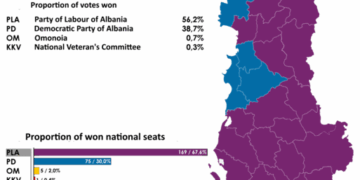
Biden-appointed Judge Adrienne Nelson of the U.S. District Court in Oregon found a way to keep the state’s onerous and unconstitutional ban on ghost guns in place.
She ruled that although “bearable,” they are not “bearable for lawful purposes.”
The language of the Second Amendment is clear:
A well-regulated Militia being necessary to the security of a free State, the right of the people to keep and bear Arms, shall not be infringed.
But, relying on other courts’ rulings that to “bear” must mean only “bearable for lawful purposes,” she denied the motion by the Firearms Policy Coalition (FPC) on Tuesday to issue a temporary restraining order (TRO) against the law, which becomes fully effective on September 1.
House Bill 2005
The law prohibits the manufacturing of “undetectable firearms” that are “constructed or produced, including through a three-dimensional printing process, entirely of nonmetal substances.” Possession of a ghost gun is a misdemeanor. Making one is a felony, punishable by up to 10 years in jail and a $250,000 fine.
Oregon Governor Tina Kotek signed House Bill 2005 into law last year, with it becoming enforceable on September 1, 2024. It was another attempt to undermine the Second Amendment and a response to the change in the judicial landscape under the Supreme Court’s ruling in Bruen in 2022.
The Judge’s Ruling
Judge Nelson wrote:
The Second Amendment does not protect the right to keep and bear all firearms.… In Heller, the Supreme Court stated that “the Second Amendment does not protect those weapons not typically possessed by law-abiding citizens for lawful purposes, such as short-barreled shotguns.”… [Emphasis in original.]
Therefore, to assess whether plaintiffs’ conduct falls under the Second Amendment’s protection, plaintiffs must demonstrate that unserialized firearms, undetectable firearms, and unserialized, unfinished frames and receivers are bearable arms in common use by law-abiding citizens for lawful purposes.
Defendants’ arguments focus primarily on the common use and lawful purpose aspects, and they do not substantively address whether these items constitute bearable arms.
Thus, the Court considers this point conceded for purposes of this motion.
Translation: Since the FPC failed to buy into the argument presented by the state of Oregon, it conceded the point, giving the judge all the room she needed to rule against its request for a TRO.
She wrote:
Defendants [the State of Oregon] have proffered evidence indicating that unserialized and undetectable firearms are increasingly used for distinctly unlawful purposes.
Then she rolled out the standard mantra that guns being undetectable makes the job of law enforcement more difficult. She quoted from a previous case:
The absence of markings on PMFs [privately made firearms] makes it extremely difficult for law enforcement to determine where, by whom, and when they were manufactured, and to whom they were sold or otherwise disposed.
Are Serial Numbers Used in Tracing?
She conveniently ignored at least two critical points: One, most firearms used by criminals have been obtained illegally, and two, law enforcement uses shell casings rather than serial numbers to trace a firearm used in a criminal incident.
Portland Police Lt. Ken Duilio leads teams charged with investigating and preventing gun violence. He noted that the new law would have a minimal impact on crime. In 2022, just 48 of the 1,364 firearms recovered, or 3.5 percent, would have been banned under the new law.
He added that tracing a firearm using the serial number can sometimes be helpful, but most of their investigations focus on using the unique markings each gun — privately or commercially made — leaves on the shell casings left behind.
Back to Judge Nelson’s flawed reasoning. In ruling against FPC’s request, she wrote that the State of Oregon
offered substantial evidence indicating that, to the extent unserialized firearms are in common use [as required now under Bruen], they are in common use for unlawful [her emphasis] purposes…. Plaintiffs [FPC] have offered no evidence as to why, aside from illicit purposes, a law-abiding citizen would prefer an undetectable firearm.
In her mind, the mere possession (or manufacture) of a “ghost gun” is unlawful, not protected by the Second Amendment. It makes perfect sense for a judge whose predilection opposes it.
Additional Efforts to Prevent Crime
Interestingly, while gun violence in Oregon continues to increase, crime in the state’s biggest city, Portland, has declined substantially. The reason? Efforts by Ceasefire and Safer Portland, community initiatives designed to target potential criminals instead of crime. Those efforts have been focused on the “very small and very high-risk population that is driving a significant portion of the gun violence in Portland,” according to Ceasefire. Said Safer Portland director Elisabeth Perez:
We want to make sure that there are things like mentoring, workshops, sports, arts, and internships that [we] can apply to have positive ways [for potential lawbreakers] to spend their time.
These efforts are supported by Bearing Arms journalist Cam Edwards. “If you want to reduce violent crime, you have to target the most prolific offenders, not lawful gun owners,” he said.
Going after lawful gun owners and makers through this law reflects the views of anti-gun reactionaries populating the state’s Legislature. As Fredy Riehl, editor-in-chief of Ammoland, noted:
Oregon lawmakers’ incessant urge to subjugate the people is truly insatiable, and Oregon’s judge’s blatant and arrogant disregard for the Supreme Court’s clear dictates is chilling.
Related article:

































